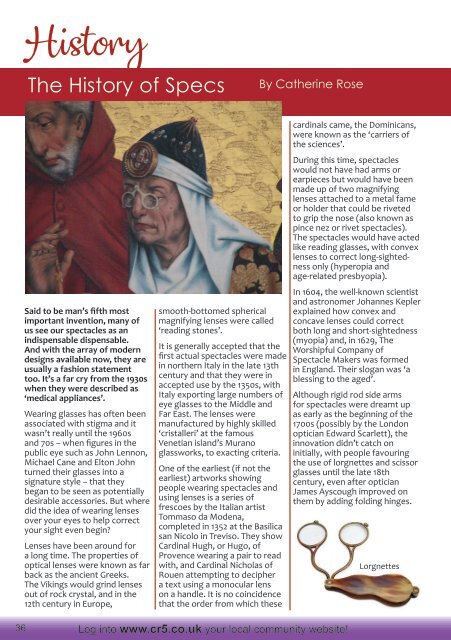CR5 Issue 161 Oct 2018
A local community magazine delivered free to 11,600 homes every month in the CR5 postcode. Contains local business advertising, interesting reads, Competitions, What's on in the Community and puzzles.
A local community magazine delivered free to 11,600 homes every month in the CR5 postcode. Contains local business advertising, interesting reads, Competitions, What's on in the Community and puzzles.
You also want an ePaper? Increase the reach of your titles
YUMPU automatically turns print PDFs into web optimized ePapers that Google loves.
History<br />
The History of Specs<br />
By Catherine Rose<br />
Said to be man’s fifth most<br />
important invention, many of<br />
us see our spectacles as an<br />
indispensable dispensable.<br />
And with the array of modern<br />
designs available now, they are<br />
usually a fashion statement<br />
too. It’s a far cry from the 1930s<br />
when they were described as<br />
‘medical appliances’.<br />
Wearing glasses has often been<br />
associated with stigma and it<br />
wasn’t really until the 1960s<br />
and 70s – when figures in the<br />
public eye such as John Lennon,<br />
Michael Cane and Elton John<br />
turned their glasses into a<br />
signature style – that they<br />
began to be seen as potentially<br />
desirable accessories. But where<br />
did the idea of wearing lenses<br />
over your eyes to help correct<br />
your sight even begin?<br />
Lenses have been around for<br />
a long time. The properties of<br />
optical lenses were known as far<br />
back as the ancient Greeks.<br />
The Vikings would grind lenses<br />
out of rock crystal, and in the<br />
12th century in Europe,<br />
smooth-bottomed spherical<br />
magnifying lenses were called<br />
‘reading stones’.<br />
It is generally accepted that the<br />
first actual spectacles were made<br />
in northern Italy in the late 13th<br />
century and that they were in<br />
accepted use by the 1350s, with<br />
Italy exporting large numbers of<br />
eye glasses to the Middle and<br />
Far East. The lenses were<br />
manufactured by highly skilled<br />
‘cristalleri’ at the famous<br />
Venetian island’s Murano<br />
glassworks, to exacting criteria.<br />
One of the earliest (if not the<br />
earliest) artworks showing<br />
people wearing spectacles and<br />
using lenses is a series of<br />
frescoes by the Italian artist<br />
Tommaso da Modena,<br />
completed in 1352 at the Basilica<br />
san Nicolo in Treviso. They show<br />
Cardinal Hugh, or Hugo, of<br />
Provence wearing a pair to read<br />
with, and Cardinal Nicholas of<br />
Rouen attempting to decipher<br />
a text using a monocular lens<br />
on a handle. It is no coincidence<br />
that the order from which these<br />
cardinals came, the Dominicans,<br />
were known as the ‘carriers of<br />
the sciences’.<br />
During this time, spectacles<br />
would not have had arms or<br />
earpieces but would have been<br />
made up of two magnifying<br />
lenses attached to a metal fame<br />
or holder that could be riveted<br />
to grip the nose (also known as<br />
pince nez or rivet spectacles).<br />
The spectacles would have acted<br />
like reading glasses, with convex<br />
lenses to correct long-sightedness<br />
only (hyperopia and<br />
age-related presbyopia).<br />
In 1604, the well-known scientist<br />
and astronomer Johannes Kepler<br />
explained how convex and<br />
concave lenses could correct<br />
both long and short-sightedness<br />
(myopia) and, in 1629, The<br />
Worshipful Company of<br />
Spectacle Makers was formed<br />
in England. Their slogan was ‘a<br />
blessing to the aged’.<br />
Although rigid rod side arms<br />
for spectacles were dreamt up<br />
as early as the beginning of the<br />
1700s (possibly by the London<br />
optician Edward Scarlett), the<br />
innovation didn’t catch on<br />
initially, with people favouring<br />
the use of lorgnettes and scissor<br />
glasses until the late 18th<br />
century, even after optician<br />
James Ayscough improved on<br />
them by adding folding hinges.<br />
Lorgnettes<br />
36 Log into www.cr5.co.uk your local community website!

















